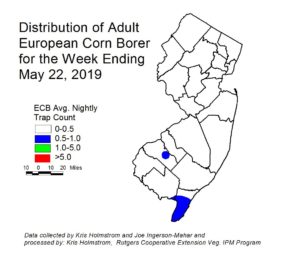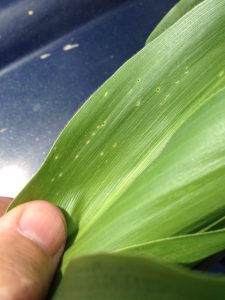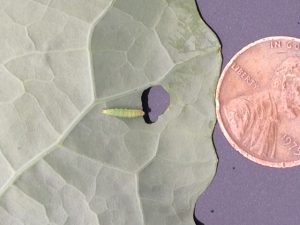Sweet Corn
 Low numbers of European corn borer (ECB) moths continue to be captured in a few traps (see map at left). Several cold nights may have suppressed the first flight of the season, although declining ECB populations due to transgenic corn may play a part in the low catches. Early plantings grown under plastic will be at risk first, followed by the first bare ground plantings. Through the central counties, a few early corn plantings have reached the whorl stage. Growers should begin scouting whorl corn for injury. Look for the characteristic “shot-hole” type of feeding (photo below at right) and consider treating when
Low numbers of European corn borer (ECB) moths continue to be captured in a few traps (see map at left). Several cold nights may have suppressed the first flight of the season, although declining ECB populations due to transgenic corn may play a part in the low catches. Early plantings grown under plastic will be at risk first, followed by the first bare ground plantings. Through the central counties, a few early corn plantings have reached the whorl stage. Growers should begin scouting whorl corn for injury. Look for the characteristic “shot-hole” type of feeding (photo below at right) and consider treating when infested plants exceed 12% in a 50 plant sample.
infested plants exceed 12% in a 50 plant sample.
The highest nightly trap catches of ECB for the week ending 5/21/19 are as follows:
| Green Creek 2 | Crosswicks 1 | Pedricktown 1 |
| Beckett 1 | Downer 1 | Princeton 1 |
| Blairstown 1 | New Egypt 1 | Woodstown 1 |
Several corn earworm (CEW) individuals have been captured in blacklight traps this week. Catches occurred at Port Colden in Warren County, Matawan in Monmouth County and Woodstown in Salem County. These individuals likely represent a limited overwintered population to our south, and arrived on the southerly breezes that occurred over the weekend and early this week. There is little threat from these CEW at this time.
Cole Crops
Increasing numbers of imported cabbageworm (ICW) and diamondback moth larvae (DBM) infestations are now occurring, with DBM (see photo at right) being the dominant species. These infestations will increase rapidly as the spring season progresses. Check 5 consecutive plants each in 10 random locations throughout the planting, paying  particular attention to the innermost leaves where ICW often feed. Consider treating if caterpillars are found on 10% or more plants that are in the 0-9 true leaf stage. From 9-leaf to the early head stage (in broccoli, cauliflower, and cabbage) infestations up to 20% may be tolerated. Once heads begin to form, a 5% threshold should be observed to protect the marketable portion of the plant. For leafy greens such as collards and kale, 10% plants infested is the threshold throughout.
particular attention to the innermost leaves where ICW often feed. Consider treating if caterpillars are found on 10% or more plants that are in the 0-9 true leaf stage. From 9-leaf to the early head stage (in broccoli, cauliflower, and cabbage) infestations up to 20% may be tolerated. Once heads begin to form, a 5% threshold should be observed to protect the marketable portion of the plant. For leafy greens such as collards and kale, 10% plants infested is the threshold throughout.
As a reminder: Some populations of DBM are resistant to carbamate and synthetic pyrethroid insecticides. The lack of DBM control with these insecticides has been noted in NJ previously. It is important to distinguish between common cole crop pests for this reason. DBM larvae grow to a length of approximately 0.5”, and taper toward both ends. These caterpillars thrash violently when disturbed. ICW grow to a length of approximately 1.25” and are covered with short hairs. Newer chemistries that specifically target caterpillar pests are effective against DBM as well as all other caterpillar pests of cole crops. These materials include (active ingredient – trade name (IRAC* code)):
Spinosad/Spinetoram – Entrust/ Radiant (5)
Chlorantraniliprole – Coragen (28)
Cyantraniliprole – Exirel (28)
The IRAC group 5 insecticide, Entrust, is OMRI approved for organic production. Insecticides based on the soil-inhabiting bacterium Bacilllus thuringiensis (B.t.) may also be effective on caterpillar pests of cole crops. Examples include Xentari and Javelin.
Flea beetles will be active in many plantings, particularly during the warmer days. These pests have a preference for the “hotter” flavored crops like arugula, mustard greens, and turnip greens. They also attack Tuscan or lacinato kale frequently. Plants may be protected with at-planting, soil-applied neo-nicotinoid insecticides (see the 2019 Commercial Vegetable Production Recommendations for products). An OMRI approved foliar material for flea beetle management is Pyganic. This product will provide knock-down of flea beetles, but may need to be applied frequently on preferred host crops.

